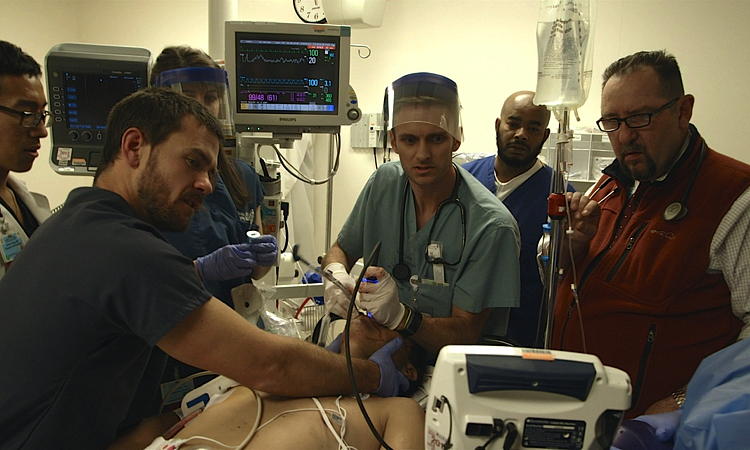By Meredith Alloway · October 11, 2013

When I agreed to interview Code Black documentary filmmaker Ryan McGarry at the LA County hospital, I had no idea what I was getting myself into. Finding parking, passing security with a video camera and dealing with suspicious guards nearly gave me a panic attack. Well, if I did have heart failure, at least I was at a hospital.
But once I entered the ER with McGarry and my videographer Chris McCreary, the relaxed atmosphere surprised me. The residents were beyond friendly and McGarry popped in to check on ill patients like stopping to give a friend a high five. I was definitely out of my comfort zone and also ridiculously intrigued.
As the night progressed I witnessed a helicopter fly in a victim and was crammed in an elevator next to a blood spewing broken leg. The doctors on either side smiled and joked and reported the women’s statistics. Meanwhile I couldn’t stop staring at the real live blood in front of me. Seeing it in films has left us desensitized. Thinking I should be freaked out, I actually felt close to nothing.
This disconnect between emotion and trauma,; paperwork and people; health care and patients became increasingly glaring during my visit. The doctors and residents at LA County had pride that was awe-inspiring. Working in the C-Booth, dubbed the “Hurt Locker of American Medicine” the residents deal with the realities of a health care system on the verge of overload. Handling countless numbers of uninsured visitors, in profuse numbers and even those transferred from the LA County jail is purely a day in the life for them.
The situations, passion and inherent characters to the environment are spectacular. It’s easy to see why McGarry approached his documentary from purely a storytelling standpoint. The revelations I had during my visit are equal to those the film delivers to its audience. Code Black’s motive is never to intentionally reveal the divide between health care and what actually occurs in an ER; although that’s a clear after effect.
The film begins with open-heart surgery, blossoming in gory bliss. It’s gruesomely ludicrous from the very beginning. McGarry allows no time for the viewer to get accustomed to this world in the C Booth. We witness the residents and doctors band together, and if they fail to keep the patient alive, grieve as one. One doctor admits, “When someone dies it connects everyone, we have the same sorrow. The next patient who comes in the door, we try and make a difference there." This sort of hope is what allows the film to transcend its potentially maudlin tone.
During one of my favorite scenes, McGarry checks in on a woman suffering from a painful sciatic nerve. When asked what meds she’s taking she replies, “Mary J.” McGarry’s face is blank and when she explains to him that it means marijuana, he jokes he doesn’t hit it much. It’s these intimate moments that illuminate the fact that the way our country approaches health care is the opposite from intimate.
The masses of people and ridiculous waiting times that LA Country residents deal with is baffling. Patients are sorted by injury and those who don’t suffer fatal ones can be kept for over 48 hours. The residents have always viewed LA County’s methods as progressive. However recently the paperwork needed to even see a patient has slowed down their process. To speed things up, the film depicts the residents re-arranging the ER completely in a cherry-picking configuration. McGarry explains, “The tradition at this institution is one of autonomy and residents are expected to rise up and be independent.”
They’re taking action and fast tracking, refusing to agree that the prescribed health care regulations are efficient.
But what makes Code Black an even more incredible documentary is that the residents themselves, as opposed to an outside artistic perspective, created it. In the hospital courtyard, the hour nearing midnight, I asked McGarry how he actually got the film made and on such a grueling work schedule. “I’m so over tired! You better clean up this language! I think it’s my 30th hour right now.”
“In 2008 we didn’t have a full crew or funding. At that point I was a medical student here and had a few buddies who had interest in film. At that point we were ingrained in the culture here as med students. We were aware of the clinical scenarios and could anticipate what could happen. We were insiders. We were ignored even with the camera which was fantastic.”
And this DIY feel is what makes the audience feel welcome into the LA county world. Welcome to greet each patient as the doctors do, fill out the stacks of tedious paperwork and in the end suffer the same frustrations with the way the health care system requires the hospital to run.
At many film festivals some of the greatest pieces slip under the radar. Flashy features shadow short films and documentaries are traded for narratives with celebrity clout. Admittedly, at LA film fest I found myself succumbing to the shinier of projects. Thankfully I was urged to see Code Black.
It’s easy to have an opinion about our health care system from the safety of a computer, protesting or defending our laws through social media or over dinner with friends. When meeting the people who are actually emerged in the system and must deal with it’s imperfections, it’s hard not to want to challenge and improve the status quo.
Code Black leaves us asking, ‘Can health care in America exist when faced with the realities of life and death from within an emergency room?’ The documentary doesn’t provide any ideals it claims as answers, but it offers an enlightening perspective that’s hard to ignore.